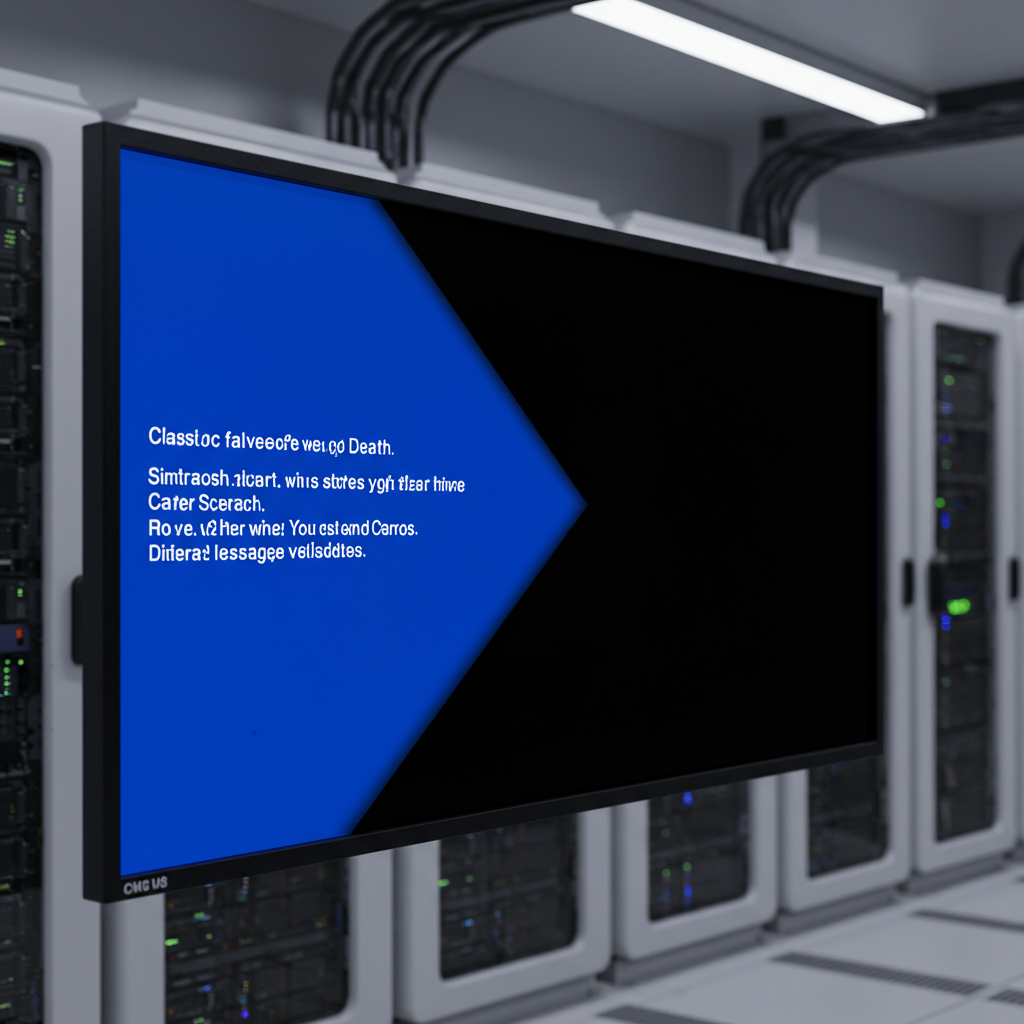For decades, the sight of a vivid blue screen filled with white text has struck a unique blend of dread and frustration into the hearts of Windows users worldwide. This infamous “Blue Screen of Death” (BSOD) signaled a critical system error or unexpected shutdown, a moment often followed by lost work and uncertain recovery. But now, after more than 40 years as Windows’ stark blue messenger of doom, this iconic error screen is set for a dramatic transformation. microsoft is changing its color, and the blue is turning to black.
This significant visual overhaul isn’t just about aesthetics. The shift is part of a broader, strategic push by Microsoft to enhance the resilience and recovery capabilities built into the Windows operating system. It reflects a direct response to recent challenges, particularly the widespread disruptions experienced during last year’s major CrowdStrike incident.
The End of an Era: Why the Blue is Going Black
The familiar blue backdrop of the critical system error screen has been a staple of the Windows experience since the early 1990s. It became an almost universally recognized symbol of PC trouble. However, its lengthy tenure is concluding. Microsoft is retiring the blue for a new, dark background.
This change is deeply connected to efforts to improve the reliability and recovery speed of Windows. Microsoft explicitly links these updates to lessons learned from the 2023 CrowdStrike incident. That event caused millions of Windows systems globally to crash. Airlines, hospitals, emergency services, and banks relying on these systems faced significant disruption. Reports indicated approximately 8.5 million systems crashed, leading to billions of dollars in losses from lost productivity and remediation efforts. Following this widespread failure, Microsoft committed to strengthening its cyber resilience measures. The updated error screen is a visible component of this renewed focus.
Beyond Color: What the New Black Screen Shows
The transition from blue to black is the most noticeable change, but it’s far from the only one. The redesigned error screen aims to streamline the user experience during system failures. Microsoft describes this updated interface as “simplified.”
Beyond the now-black background, the message displayed is slightly more concise than before. Perhaps more significantly for user experience, the long-standing frowning face icon that accompanied the blue screen is gone. In its place, the new screen will feature a percentage indicator. This percentage shows the progress of the system’s restart process. Microsoft believes this provides users with more concrete information during a stressful event. The company stated that these updates are designed to make it “easier than ever to navigate unexpected restarts and recover faster.”
This revamped error screen, complete with its black background and simplified information, is scheduled for release later in the summer of 2024. It will be included as part of the Windows 11 version 24H2 update. The update will roll out to all devices running this specific version of the operating system.
Introducing Quick Machine Recovery: A New Safety Net
Alongside the visual update to the error screen, Microsoft announced another critical tool: a new “quick machine recovery” mechanism. This feature provides an additional layer of defense for situations where a PC fails to restart successfully after encountering an error.
This recovery mechanism is particularly valuable during large-scale outages or widespread issues affecting numerous machines simultaneously. Microsoft highlights that it will allow the company to “broadly deploy targeted remediations.” It enables automated fixes across vast numbers of systems efficiently. A key benefit is that it can address problems “without requiring complex manual intervention from IT.” This promises a more streamlined and potentially faster resolution process for system problems, especially in enterprise environments.
For users, the quick machine recovery tool means less potential downtime. Microsoft anticipates this feature, along with other related improvements, will significantly reduce the time it takes for a PC to restart after an issue. David Weston, Microsoft’s vice president of enterprise and OS security, mentioned in an interview that restart times could be reduced to approximately two seconds for most users. The primary goal is to improve clarity and provide better diagnostic information. This helps both Microsoft and users identify the root cause of issues more quickly.
The quick machine recovery feature is also slated to become generally available later this summer. It will launch on Windows 11 initially. Microsoft has indicated plans to introduce additional capabilities for this recovery mechanism later in the year.
The Strategic Shift: Improving Windows Resilience
These two announcements – the black error screen and the quick recovery tool – represent more than isolated changes. They are integral components of a strategic initiative to bolster the cyber resilience of Windows. The focus is clearly on minimizing disruption caused by unexpected restarts and system failures.
The updated error screen provides cleaner information about what went wrong. It helps distinguish between issues originating within Windows itself and those related to a specific hardware or software component. This clarity is crucial for faster troubleshooting and problem resolution. Combined with the quick machine recovery tool, Microsoft is building a more robust system. This system aims to recover automatically where possible and provide clearer directions when manual intervention is needed.
Improving system reliability directly impacts user trust and productivity. By addressing the moments of failure more effectively, Microsoft seeks to reduce frustration and downtime. The ultimate goal is to make Windows more dependable, particularly in an era where system stability is paramount for both individual users and global infrastructure.
What This Means for You
As a Windows user, encountering a critical error is never pleasant. The change from a bright blue screen to a black one might seem minor, but it signals deeper improvements. The presence of a percentage lets you know something is happening, rather than leaving you staring at a static blue wall of text. It provides a small piece of actionable information.
The quick machine recovery feature offers a more tangible benefit. While most users might not interact directly with its automation capabilities during a widespread outage, it means Microsoft has a better toolset to get systems back online faster. This could potentially prevent the kind of prolonged disruption seen in past incidents. These changes are coming soon. You can expect to see the new black screen and potentially benefit from the improved recovery process once you update to Windows 11 version 24H2 later this summer. Staying updated is key to accessing these new resilience features.
Frequently Asked Questions
Why is Microsoft changing the Blue Screen of Death to black?
Microsoft is changing the iconic blue error screen to black as part of a broader effort to improve Windows system resilience and recovery capabilities. This move is linked to addressing lessons learned from events like the 2023 CrowdStrike incident, which caused widespread system crashes. The new black screen is intended to be part of a more streamlined and simplified user experience during unexpected restarts, providing clearer information to help users and IT identify issues faster.
When will the black screen and quick machine recovery tool be available?
Both the updated error screen with a black background and the new quick machine recovery mechanism are scheduled to become generally available later in the summer of 2024. These features will be introduced as part of the Windows 11 version 24H2 update. Users who update to this version will see the changes and gain access to the new recovery capabilities.
How will this update improve PC reliability for users?
The changes aim to improve reliability by making it easier to navigate and recover from unexpected restarts. The new black screen provides clearer information and shows restart progress (via a percentage), offering users more insight. The quick machine recovery tool enables faster automated fixes, especially during widespread issues. Together, these features are designed to reduce downtime, simplify troubleshooting, and improve the overall speed and efficiency of system recovery after a critical error.
These updates represent a significant evolution in how Windows handles critical system failures. By changing the familiar blue screen and introducing enhanced recovery tools, Microsoft is actively working to make the operating system more robust and user-friendly, even in moments of crisis. The arrival of the black screen marks not just a visual change, but a step forward in system resilience.
Word Count Check: 920 words




